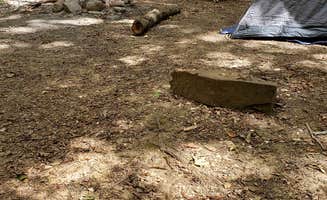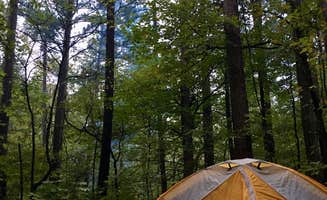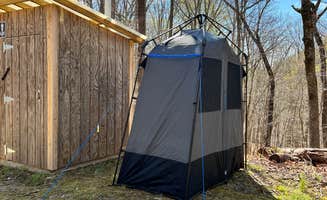Dispersed camping near Whittington, Illinois provides primitive outdoor experiences within the forested hills of southern Illinois, where elevations range from 400 to 700 feet. The region experiences typical Midwestern seasonal patterns with humid summers often reaching 90°F and winters dropping below freezing. Fall camping draws visitors for vibrant foliage displays while spring brings wildflower blooms alongside sometimes challenging trail conditions from seasonal rainfall.
What to do
Climbing routes at Jackson Falls: The sandstone formations provide approximately 60 technical climbing routes with varying difficulty levels, making this area one of southern Illinois' premier climbing destinations. According to a visitor, "This place is popular with climbers, but I'm not one and had a rough time locating this place. The roads weren't marked the same way they are on the website's map, and the trailheads are confusing as well."
Hike the lake trail: At Lake Glendale Recreation Area, campers can enjoy a moderately challenging 3-mile loop around the lake. "The trail around the lake is about 3 miles; a nice hike that really gives you a good look at the park. On the hike you pass two large shelters built by the CCC as well as the boat ramp, damn, and swimming beach," notes one reviewer.
Visit historical sites: The region contains numerous historical markers and preserved areas, including CCC structures and segments of the Trail of Tears. A camper mentioned, "There are several historical sites in area. Illinois Iron Forge, Garden of the Gods, and segments of the Trail of Tears." These sites provide educational opportunities while exploring the national forest.
Fishing opportunities: Many dispersed sites offer access to fishing spots in small lakes and streams. At Dutchman Lake Camp, anglers report good fishing conditions: "Great little spot right off the interstate. Lots of nice scenery and decent fishing." Most fishing spots require no special permits beyond an Illinois fishing license.
What campers like
Remote locations: The primitive nature of dispersed camping in this region provides solitude not found at developed campgrounds. At Trail of Tears State Forest, a camper noted it's "Excellent for tent camping when you want relatively easy access and still feel a bit of solitude." Many sites provide sufficient privacy despite their relative accessibility.
Cost efficiency: Free or low-cost camping makes the Shawnee National Forest appealing for budget-conscious travelers. One visitor to Trail of Tears State Forest mentioned, "Not free but worth the $8/night. Surprised to find nice porta potty at our site that was remote from others." Most dispersed sites are completely free with a 14-day maximum stay.
Scenic diversity: The mix of sandstone formations, mature forests, and small waterways creates varied landscapes for exploration. At Dispersed Campsite Shawnee National Forest, a visitor commented, "Love this spot! It's easily accessible by all rig types. Backs up to the open forest and you pull right back onto the highway." These accessible sites serve as convenient basecamps for day trips.
Natural features: Rock formations, seasonal waterfalls and mixed hardwood forests provide year-round interest. A camper at Jackson Falls shared, "The place is beautiful; forests and great big, moss covered boulders. It was fun climbing down to the bottom of the falls, even with small kids." Water features vary significantly by season, with many falls running dry during summer months.
What you should know
Weather challenges: Rain can significantly impact access roads and campsite conditions. One visitor to Jackson Falls noted, "Definitely off the beaten path...Hill down to trail head could get slick if wet weather. Was a little nervous getting out after it had rained. But luckily it wasn't to much rain." Always check weather forecasts before traveling on forest service roads.
Facilities limitations: Most dispersed sites lack amenities commonly found at established campgrounds. As one reviewer at Jackson Falls Dispersed mentioned, "It's worth mentioning that I didn't have T-Mobile cellphone reception and the bathroom was a bit dirty." Plan to bring everything you need, including water and waste disposal options.
Navigation difficulties: Forest roads and trail markers can be confusing or insufficient. A camper shared, "Be sure to make sure you set the correct location into GPS. We ended up at the wrong location at first try." Download offline maps before entering areas with poor cell service.
Water considerations: Surface water should be treated before consumption, and seasonal fluctuations affect water availability. One camper observed, "We went during a dry spell and there was no running water at the falls! Still had a blast there though!" Many locations have no reliable water source during summer and fall.
Tips for camping with families
Choose appropriate sites: Some dispersed areas offer better facilities for family camping than others. At Lake Glendale, a visitor noted, "Lake Glendale is a true southern Illinois gem. They have recently improved the shower houses, the kids love the playground, and there is SO much shade!" Developed campgrounds can provide a better experience for young children.
Wildlife awareness: Teach children about ticks and poison ivy which are prevalent in the area. A reviewer mentioned, "Important to note that there are lots of ticks and poison ivy everywhere." Bring appropriate repellents and teach children how to identify problem plants.
Activity planning: Schedule family-friendly hikes and activities based on difficulty level and distance. According to one visitor, "It was fun climbing down to the bottom of the falls, even with small kids. The site is popular and there was a good amount of people on Labor Day weekend, however secluded camp sites were easy to find."
Alternative accommodations: Consider campgrounds with more facilities during extreme weather. One reviewer suggested, "For more wild hiking, go down the road 15 minutes to Bell Smith Recreation area (which has its own campground) and hike to the natural rock bridge (and climb the steel ladder), springs, or Devils Backbone."
Tips from RVers
Access limitations: Many dispersed sites have challenging access roads unsuitable for larger RVs. At Jackson Falls, one RVer reported, "We run a 28ft RV and we're able to cross the first water wash without problem. We are a Jeep family so I may have more experience than others in off-roading." Consider your experience level before attempting forest roads with an RV.
Parking options: Look for designated parking areas that accommodate larger vehicles. "We opted to turn around and stay at the main parking lot which is VERY accessible. The further sights will require crossing several wash outs," noted a Jackson Falls visitor. The main parking areas often provide better options for overnight stays with larger vehicles.
Road conditions: Forest road quality varies seasonally and after weather events. A camper shared, "Grave Road getting there was a bit rough for my Ram Promaster...Definitely coming back when warmer." Spring thaws and heavy rains can make roads temporarily impassable even for high-clearance vehicles.




